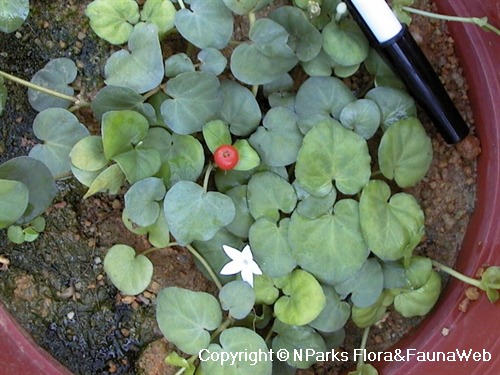
Back
Geophila herbacea (Jacq.) K.Schum.
| Family Name: | Rubiaceae |
| Synonyms: | Geophila repens auct. non (L.) I.M.Johnst., Geophila reniformis Cham. & Schltdl. var. asiatica, Geophila repens (Cham. & Schltdl.) Fosberg var. asiatica, Rondeletia repens L. |
| Common Name: | Snake Pennywort, Pegaga tekukur, Pegaga ular, 爱地草 |
Name
Classifications and Characteristics
| Plant Division | Angiosperms (Flowering Seed Plants) (Dicotyledon) |
|---|---|
| Plant Growth Form | Herbaceous Plant, Creeper |
| Lifespan (in Singapore) | Perennial |
| Mode of Nutrition | Autotrophic |
| Plant Shape | Irregular |
Biogeography
| Native Distribution | China, south and Southeast Asia (including Singapore), and Polynesia |
|---|---|
| Native Habitat | Terrestrial (Primary Rainforest, Secondary Rainforest, Coastal Forest) |
| Preferred Climate Zone | Tropical |
| Local Conservation Status | Native to Singapore (Endangered (EN)) |
Description and Ethnobotany
| Growth Form | It is a creeping herb, with upright branches up to about 0.08 m tall. |
|---|---|
| Foliage | Its opposite, stalked leaves have leaf blades that are heart-shaped, and 1.3–3.8 cm long and wide. |
| Flowers | Its white flowers are trumpet-shaped, up to 1.5 cm long, and found 1–3 together at the ends of slender stalks. |
| Fruit | Its pea-sized fruits are bright orange-red berries with narrow sepals on its tip. |
| Habitat | It grows in open, or shaded, damp places in the understorey of forests, secondary growth, and vegetation near the sea. It occurs locally in Kampong Glam, Makeway Avenue, and Fort Canning Park. |
| Associated Fauna | Its flowers are insect-pollinated. |
| Taxonomy | Previous name of Geophila repens auct. non (L.) I.M.Johnst. was misused in Asia. Current name of Geophila herbacea (Jacq.) K.Schum. is applicable to all wild plants in Asia and cultivated plants of Asian origin. |
| Cultivation | It can be propagated by seed, stem cuttings, and has been cloned by micropropagation technique. |
| Etymology | Greek ge, the Earth; Greek phileo, to love, alluding to the creeping habit of the plant; Latin repens, creeping, referring to the plant’s growth form. |
| Ethnobotanical Uses | Medicinal: The plant is applied to sore legs as a poultice. Diarrhoea can also be by taking the plant. |
Landscaping Features
| Landscaping | This creeper has attractive, bright orange red berries. Its habit and shape of its leaf blade also vaguely resemble the pennywort (Centella asiatica), hence its common name. It may make a good ground cover for shaded to semi-shaded sites that are sufficiently moist and cool. |
|---|---|
| Desirable Plant Features | Ornamental Flowers, Ornamental Foliage, Ornamental Fruits |
| Landscape Uses | General, Parks & Gardens, Groundcover |
Fauna, Pollination and Dispersal
| Pollination Method(s) | Biotic (Fauna) |
|---|---|
| Seed or Spore Dispersal | Biotic (Fauna) |
Plant Care and Propagation
| Light Preference | Semi-Shade |
|---|---|
| Water Preference | Moderate Water |
| Plant Growth Rate | Moderate |
| Rootzone Tolerance | Moist Soils, Well-Drained Soils, Shallow Media |
| Propagation Method | Seed, Stem Cutting, Tissue Culture |
Foliar
| Foliage Retention | Evergreen |
|---|---|
| Mature Foliage Colour(s) | Green |
| Foliar Type | Simple / Unifoliate |
| Foliar Arrangement Along Stem | Opposite |
| Foliar Attachment to Stem | Petiolate |
| Foliar Shape(s) | Non-Palm Foliage |
| Foliar Venation | Pinnate / Net |
| Foliar Margin | Entire |
| Foliar Apex - Tip | Obtuse, Rounded |
| Foliar Base | Cordate |
| Leaf Area Index (LAI) for Green Plot Ratio | 4.5 (Shrub & Groundcover - Dicot) |
Floral (Angiosperm)
| Flower Colour(s) | White |
|---|---|
| Flower Grouping | Solitary |
| Flower Location | Axillary |
| Flower Symmetry | Radial |
Fruit, Seed and Spore
| Mature Fruit Colour(s) | Red |
|---|---|
| Fruit Classification | Simple Fruit |
| Fruit Type | Fleshy Fruit , Non-Accessory Fruit |
Image Repository
Others
| Master ID | 735 |
|---|---|
| Species ID | 2030 |
| Flora Disclaimer | The information in this website has been compiled from reliable sources, such as reference works on medicinal plants. It is not a substitute for medical advice or treatment and NParks does not purport to provide any medical advice. Readers should always consult his/her physician before using or consuming a plant for medicinal purposes. |

